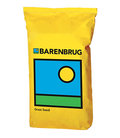Using Ryegrasses on a Golf Course
Research and development manager David Greenshields explores how perennial ryegrasses can be successfully used on golf courses.

Research and development manager David Greenshields explores how perennial ryegrasses can be successfully used on golf courses.
Commercial Manager David Greenshields explores how perennial ryegrasses can be successfully used on golf courses.
With the UK experiencing long summers and more golfers playing, there are big challenges for turf management on many golf courses. As a result, those grass areas that get a lot of traffic, especially tees and walkways, have been suffering. Using a quality perennial ryegrass solution can have a massive improvement on the wear tolerance and longevity of your tees, walkways and divot repairs.
Changing opinions
In some quarters, there is still a stigma attached to using ryegrass on golf courses, but this is changing. The grass species for golf have developed so much in recent times that I would be hard pushed to think of any golf course in the UK that wouldn’t benefit from its use in certain areas. The key is to make sure you choose the right combination of cultivars for each specific job.
It’s all about the grass variety blend
Specific applications and environmental conditions demand different characteristics and performance capability of grass for golf courses. Within the ryegrass species, characteristics such as tolerance to wear, drought, disease, salt, shade, mowing height, cool temperature growth, leaf width, colour and recovery following stress vary considerably. The extensive ryegrass breeding and applied research and development programmes at Barenbrug enables us to offer greenkeepers a distinct range of grass cultivars in blends and mixtures, which are specifically designed to meet these varied demands.
For example, wear tolerance is a difficult characteristic to quantify. It is most commonly assessed by analysing visually or by objective means how much ground cover persists after a period of artificial or real wear. Barenbrug undertake wear trials at many of our Research Stations, including our trial site at Cropvale in Worcestershire and at Bingley, as part of the BSPB Turfgrass Seed Booklet assessments. In terms of individual cultivars, Barorlando, Barcristalla and Barolympic have excelled in recent years.
Different wear actions impact varying degrees of damage, whether through high footfall on golf courses or the demands of a tee. Environmental conditions and maintenance programmes also impact on the capability of a cultivar to withstand wear pressure. Wear tolerance must be considered alongside such pressures as disease, mowing height, shade, nutrient input and drought when choosing your blend of ryegrasses. Such constraints significantly influence its capability to tolerate wear. In almost all circumstances, a combination of varieties – a tailored synergistic seed mixture – will outperform any individual cultivar.
Choosing perennial ryegrass for close mowing
When considering ryegrass varieties for use in golf, fineness of leaf is a particularly important characteristic. There is a strong correlation between fine leaf width and the ability of a cultivar to tolerate the lower heights of cut associated with golf. In addition, it is common for ryegrasses to be blended with fine fescues – put simply, the finest ryegrasses look far better aesthetically in a mixed sward.
The graph below highlights the remarkable breeding achievements that have created an unrivalled portfolio of extremely fine-leafed cultivars for golf over the last decade. Bargold, and more recently Barsignum and Barolympic have all set new standards for the species.

Barenbrug’s Ultrafine range offers a unique solution for ryegrass reinforcement for fine turf;
If you are looking for ryegrasses with fescue for medium/fine turf applications, then selecting a variety with the finest leaf possible and mid-green colour is often considered best practice. Ultrafine 30 blends 30% ryegrass with 70% fescue to offer a good degree of wear tolerance, whilst maintaining exceptional turf quality and aesthetics.
Ultrafine 60 increases the ryegrass portion to 60%, along with 40% slender creeping fescue, to deliver a compromise to those looking for increased wear tolerance in a tight and dense sward for medium-fine turf areas. While Ultrafine 100 is the ultimate 100% ryegrass blend.
If ryegrasses are needed to combine heavy wear tolerance and close mowing, selecting a synergistic blend of varieties like EXTREME. EXTREME provides good all round disease tolerance, excellent cleanness of cut and exceptional cool-temperature germination. The adoption of EXTREME as a divot mix allows successful repairs to be made earlier and later in the year and it has even been shown to extend the playing season when used on tees for a prolonged period.
The future of ryegrasses?
The newest addition to our portfolio of golf mixtures is RPR GOLF, a blend that supplements the benefits of EXTREME with revolutionary Regenerating Perennial Ryegrass technology.
Barenbrug-bred RPR cultivars provide a new dimension for the species by being able to produce determinate stolons as they develop and grow. This development allows perennial ryegrass to spread further into its surrounding area, potentially repairing gaps in the sward as they appear. This is great news for anyone using ryegrass for divot repair or overseeding by mechanical means, such as a disc seeder, as RPR has the ability to “fill in” more quickly than conventional varieties.
RPR has been used with phenomenal global success for winter sports pitches, and now course managers and head greenkeepers have access to this exciting development in a dedicated blend for golf.

Using Barenbrug’s RPR (Regenerating Perennial Ryegrass) technology for fast establishment and unparalleled capacity for recovery from wear due to the self-regenerating growth habit.

A 30% perennial ryegrass and red fescue blend for fine turf.

A 60% blend of fine turf perennial ryegrass and red fescue.

A 100% blend of fine turf perennial ryegrasses, simply offering the best fine ryegrass on the market.